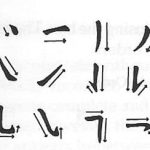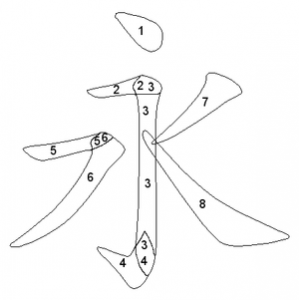Stroke Order (笔顺) Posted by Stephen on Oct 16, 2011 in Culture
Now that we’ve covered Radicals (部首) in our last post, it’s time to move on to the basics of stroke order, so we can complete our characters and improve our writing. Stroke order is an integral component to reading, writing and recognizing characters and is a valuable way to deepen your understand of Chinese character makeup, so you don’t always have to look toward a dictionary.
Stroke order or 笔顺 (bǐshùn) is the sequential order and style in which the strokes of a Chinese characters are written. A stroke is considered to be one continuous movement of a writing instrument on a writing surface–similar to a brush stroke. Because most Chinese characters have many strokes, certain stroke orders were recommended to ensure speed, accuracy, and legibility in composition and writing. As a result, a methodological approach has developed over the years that has become standardized in written Chinese.
Learning stroke order will help you better understand the radicals and components of Chinese characters, and is hugely helpful in deciphering “cursive” or fast-hand scribbles by a native speaker. Stroke order has its roots in Chinese calligraphy, but over centuries has branched out into many different styles and order associations based on cultural peculiarities. Japan, Hong Kong, Thailand and Taiwan all have different stroke order rules than the mainland style, which was forever changed in the 20th century when Mao embarked on the simplification of Chinese characters (简体字).
The following are general rules to get you started on the basics of stroke order. While learning stroke order was one of my least favorite aspects of being a Chinese student, I will admit that this seemingly outdated method of drawing characters is paramount to using Chinese dictionaries, and does give you a better respect for the artistic makeup of the Chinese written language. Learning stroke order takes practice and memorization, but there are some tricks to the trade. Check some basic rules below:
Basic Rules:
1. Write from top to bottom, and left to right. ![]()
3. Character-spanning strokes last ![]()
4. Diagonals right-to-left before diagonals left-to-right ![]()
5. Center before outside in vertically symmetrical characters ![]()
7. Left vertical before enclosing ![]()
9. Dots and minor strokes last ![]()
A more complete version of basic stroke orders can be found in the Eight Principles of Yong or 永字八法 (yǒngzì bā fǎ), which uses the single character 永 (yǒng), meaning “eternity”, to teach eight of the most basic strokes in Regular Script. We’ll get to that in our next post on Stroke Order. In the mean-time, study “永”:
Follow Steve on twitter: @seeitbelieveit

Build vocabulary, practice pronunciation, and more with Transparent Language Online. Available anytime, anywhere, on any device.
About the Author: Stephen
Writer and blogger for all things China related. Follow me on twitter: @seeitbelieveit -- My Background: Fluent Mandarin speaker with 3+ years working, living, studying and teaching throughout the mainland. Student of Kung Fu and avid photographer and documentarian.






Comments:
Anna:
This will be very helpful for the Chinese Mandarin course that I will be taking this year! Thank you so much!
harmon:
Hi,
Could someone explain the stroke order rule of 些?
I mean while the right vertical is the first stroke and not the left one? (This seems to be a contradiction to the “left to right” rule)
Thank you in advance